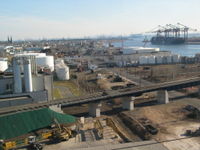I had a Firm looking for Cost Estimating services ask two (2) questions: I will post my discussion on both topics – Continuation from below question —
Answers to your questions:2. Explain how you plan to account for erratic material price increases and shortages when estimating a project.
During the last 1-2 years, Escalation, contingency allocation of commodity inflation into the future has caused havoc on cost estimating, for many owners across the world. I determined that the escalation and inflation was approaching 40% in the Food Manufacturing industry due heavy use of Stainless Steel coming from Ukraine and deliveries were 3-4 times long as what we used to call normal. At a certain point we told management to hold off on Construction Contracts until the economy came back to earth. The BOD took our recommendation.
These are the methods I’ve been successful using:
I’ve had the luxury of utilizing some expensive ($10,000/year +) on-line services like Global Insight. Their escalation and commodity Indexes all have leading 3–6-month indicators on where the anticipated prices would go. These were spot-on, looking back.
I’ve also utilized AGC Economists for Union work. (Membership required)
Used ABC Economists for Open Shop work. (Membership required)
For Government projects I tried using some of their Escalation and inflation models, but they were lagging indicators.
I looked at ENR for Commodity pricing and the ENR Index for comparison.
Every one of the sources of indexes I used were misleading or lagging indicators.
If project escalation runs “from estimate date to the mid-point of construction” during that timeframe estimates were only good in the 3–6-month window. Now that escalation and inflation are somewhat stabilizing, I would still recommend following indexes like Global Insight, until we get back to a “New Normal” again.
I would also recommend that in the Estimator Basis of Estimate (BOE) they caveat their assumptions on commodities, escalation and the source from where they used the information.
In times like the last 1-2 years, I’ve recommended a re-estimate of the projects to capture the relentless increases of the future 3-6 months.
When the customer requires accuracy ranges on the Conceptual, Budget and Definitive estimates they should pay for resources and back into your overhead and billing rate for estimators. The same with other software: Scheduling, QTO, estimating software and the RS Means data and risk Monte Carlo software.
Scheduling duration recommendations for long-lead commodities can be found in the Economist info for AGC and in Global insight information that may cost more. We also called the vendors who provided quotations to add the lead times to their quotations or we called them directly.
Risk Modeling – Estimating: Once the estimate is created, we would take the Risk Register that had high, medium, and low risks and model the estimate and the high-risk items only. We also modeled the material commodities in the Monte Carlo (@Risk) and that provided a P50 value of where the predicted value would be if owner tolerance was at a P50 (50% of the projects are winners and 50% of the projects were losers).
Many of my clients and project stakeholders wanted a P80 during this timeframe.
At P50 this needs to be subtracted from the cost estimate baseline which equals a delta $ value which is considered Contingency value for Project.
Any dollars from P50 to P80 are considered Management Reserve.
Risk Modeling – Scheduling: We used Primavera Project Risk Analyzer (PRA) to model the Baseline schedule or the latest Schedule update. Some say the new versions of P6 don’t let schedulers use PRA. There is a way.
We would model the Procurement durations on the schedule with the median value being the value given by the Vendor(s).



